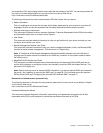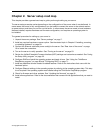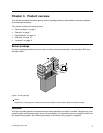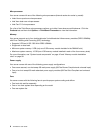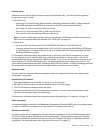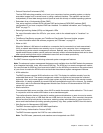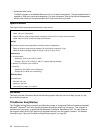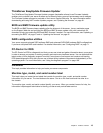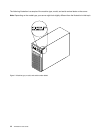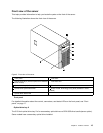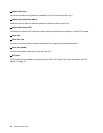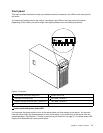
Reliability, availability, and serviceability
Reliability, availability, and serviceability (hereinafter referred to as RAS) are three important server design
features. The RAS features help you to ensure the integrity of the data stored on the server, the availability of
the server when you need it, and the ease with which you can diagnose and correct problems.
Your server has the following RAS features:
• Security features
– Server locks (see “Server locks” on page 22)
– Administrator password and user password to help protect unauthorized access to the server (see
“Using passwords” on page 65)
– Trusted Platform Module (TPM) connector on the system board for a TPM module, which is a security
chip, to help protect your server and strengthen server security
Note: The TPM module is only available in some models.
– Remote monitoring or control by an administrator to provide protection or help
– Hot-swap redundant power supply modules to help you avoid signicant interruption to the operation
of the system when a power supply module fails (available in some models)
• Basic system management features
– Ability to store the power-on self-test (POST) hardware test results
– BIOS Setup Utility program
The BIOS Setup Utility program helps you view the server information and congure the server in the
pre-operating system environment. See “Using the Setup Utility program” on page 55
.
– BMC and Intelligent Platform Management Interface (IPMI) 2.0
The system board platform management subsystem is based on the integrated BMC features. The
BMC is a management chip that is integrated on the system board of your server. With the BMC chip,
no matter what condition the server operating system is in and no matter if the server is on or off, as long
as the server is connected to network and an ac power source, the interaction with the BMC controlled
servers can be achieved through system network. The user can obtain the server hardware health
information and system event log (SEL), and is able to conduct the operations including turning on or
off the server, restarting the server, locking the power switch on the front panel, and so on. This part of
the server management is independent of the operating system and is called out-of-band management.
The system board platform management subsystem consists of the integrated BMC, communication
buses, sensors, Basic Input Output System (BIOS), and server management rmware. It is responsible
for error management and reporting, system power control, thermal monitoring, system fan control,
and other management features. The BMC provides system management and monitoring features
based on the IPMI 2.0 specication. IPMI helps lower the overall costs of server management. You can
nd more information about IPMI 2.0 from the Web site of Intel. The BMC also supports some non-IPMI
features, such as the Dynamic Host Conguration Protocol (DHCP) and the Platform Environment
Control Interface (PECI), to provide more system management functions.
Refer to the Remote Management Module User Guide on the documentation DVD that comes with your
server for more information.
– Hot-swap feature
Some models support hot-swap hard disk drives and or hot-swap redundant power supply modules.
With the hot-swap feature, you can install, remove, or replace hard disk drives or a failing power supply
module without turning off the server.
10 ThinkServer User Guide




